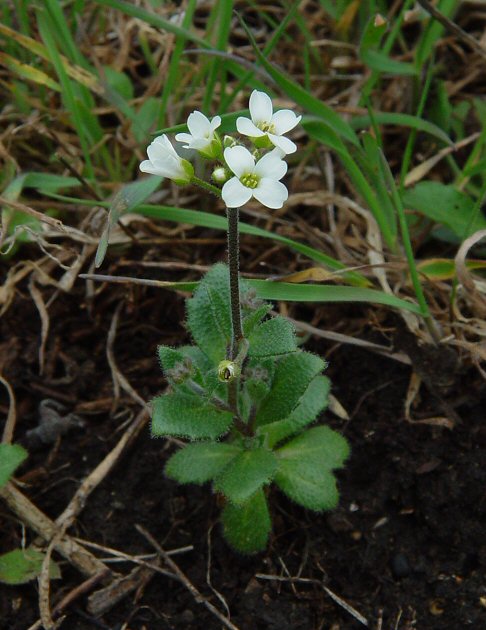Draba cuneifolia Nutt. ex Torr. & A. Gray
Whitlow Grass

Native
CC = 5
CW = 5
MOC = 59
© DETenaglia
Draba cuneifolia Nutt. ex Torr. & A. GrayWhitlow Grass | |
 |
Native CC = 5 CW = 5 MOC = 59 |
© DETenaglia |
|
Family - Brassicaceae Habit - Taprooted annual forb. Stems - Ascending to erect, to 30 cm, 1 per plant but usually branched from near the base, hairy from the base to the tip of the inflorescence axis with simple and branched hairs.
Leaves - In a basal rosette and also a few to several alternate, toward the bases of the stem branches, 0.5-5.0 cm long, sessile or nearly so, spatulate to oblanceolate, the margins noticeably few-toothed, especially above the middle, deep shiny green above, silvery green below, densely hairy on both surfaces with simple and branched hairs, the hair bases usually noticeably pustular.
Inflorescences - Terminal unbranched racemes. Flowers almost always scattered along the inflorescences. Pedicels to 4 mm long in flower, longer in fruit, densely pubescent with simple and branched hairs.
Flowers - Sepals 4, 1-2 mm long, pubescent externally with simple and branched hairs, glabrous internally. Petals 4, distinct, 2-5 mm long, white, rounded or more usually with a broad, shallow notch at the tip, glabrous. Claw to 1 mm long, slightly greenish. Limb to 4 mm long, 3 mm broad, emarginate at the apex, entire. Stamens 6, 4 larger and 2 smaller, distinct, erect. Ovary 2-locular, sessile. Styles absent or to 0.1 mm long.
Fruits - Siliques 6-15 mm long, linear to narrowly oblong in outline, hairy. Seeds 20-80 per fruit.
Flowering - February - May. Habitat - Edges and tops of bluffs, rocky open glades and ledges, rocky open woods. Typically on calcareous substrates. Origin - Native to the U.S. Lookalikes - Other species of Draba; more broadly, small species of Cardamine and other springtime mustards. Other info. - This springtime mustard is found throughout much of Missouri but is uncommon or absent in the Bootheel and large areas north of the Missouri River. Beyond Missouri its main range is in the southern half of the continental U.S., extending from Alabama to California and also into Mexico. It is easily recognized by its shining white flowers in the 4-petaled mustard pattern and its distinctive basal leaves bearing branched hairs. The petals are only slightly notched, if at all, and the leaves are confined to the near-basal portion of the stem. The plant can form cleistogamous flowers which self-pollinate without opening. These do not have petals. Photographs taken at Danville Conservation Area, Montgomery County, MO., 3-19-04 (DETenaglia); also at Young Conservation Area, Jefferson County, MO, 4-17-2013; Matson Hill County Park, St. Charles County, MO, 4-14-2016; and Shaw Nature Reserve, Franklin County, MO, 4-13-2023 (SRTurner). |